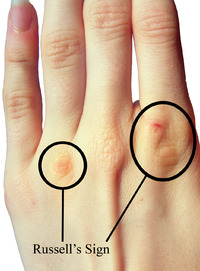| Russell's sign | |
|---|---|
 | |
| Differential diagnosis | indirect sign of bulimia nervosa or anorexia nervosa |
Russell's sign, named after British psychiatrist Gerald Russell, is a sign[1] defined as calluses on the knuckles[2] or back of the hand due to repeated self-induced vomiting over long periods of time. The condition generally arises from the afflicted's knuckles making contact with the incisor teeth during the act of inducing the gag reflex at the back of the throat with their finger(s).
This type of scarring is considered one of the physical indicators of a mental illness, and Russell's sign is primarily found in patients with an eating disorder such as bulimia nervosa or anorexia nervosa. However, it is not always a reliable indicator of an eating disorder; there are many more factors associated with it.
Bulimics who are capable of "handsfree purging", or the induction of vomiting by the willful opening of the esophageal sphincter in a manner similar to belching, while contracting the stomach muscles, do not have Russell's sign.
References
- ^ Tyler I, Birmingham CL (November 2001). "The interrater reliability of physical signs in patients with eating disorders". Int J Eat Disord. 30 (3): 343–5. doi:10.1002/eat.1094. PMID 11767717.
- ^ Strumia R (2005). "Dermatologic signs in patients with eating disorders". Am J Clin Dermatol. 6 (3): 165–73. doi:10.2165/00128071-200506030-00003. PMID 15943493. Archived from the original on 2013-02-09.